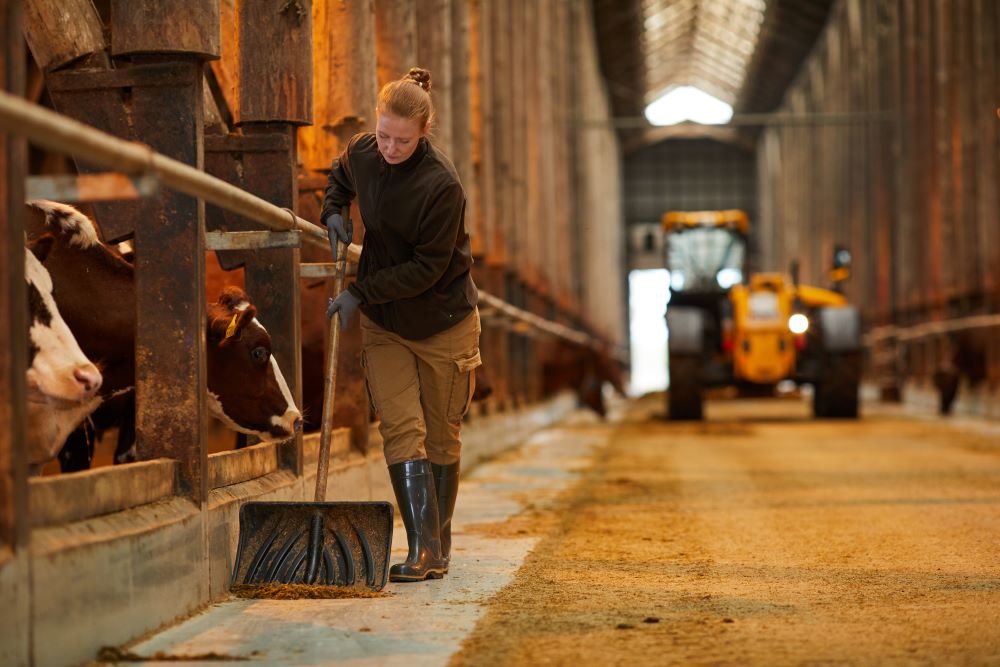From £6.99

Ultimate Guide to Deep Clean Your Livestock Sheds
Livestock housing plays a crucial role in the health and well-being of your animals. One of the key aspects of maintaining a healthy environment for your livestock is through deep cleaning. By regularly deep cleaning your livestock sheds, you can ensure that your animals are kept in a clean and safe environment. In this ultimate guide, we will explore the importance of deep cleaning in livestock housing and provide you with top tips on how to effectively deep clean your livestock sheds.
Understanding the Importance of Deep Cleaning in Livestock Housing
Deep cleaning of livestock sheds is not simply a task on the farmer's to-do list; it is a fundamental aspect of ensuring the health and prosperity of the animals housed within. Accumulated grime, debris, and pathogens pose significant health risks, making the environment conducive for the outbreak of diseases and infections. By rigorously removing these undesirable elements, one essentially cuts down the avenues through which illnesses can proliferate amongst livestock.
Moreover, the ambiance of the shed significantly influences the respiratory health of the animals. A shed choked with dust and ammonia can impair lung function, leading to chronic respiratory conditions. Regular deep cleaning aids in maintaining an environment that supports rather than undermines the respiratory wellness of your livestock.
Another less obvious yet critical advantage of deep cleaning is the positive impact on the structural integrity of the shed itself. Over time, the corrosive effects of urine, faeces, and other organic materials can erode the shed's materials, leading to premature decay and the need for costly repairs.
In essence, the process of deep cleaning transcends mere cleanliness. It is an investment in the overall health ecosystem of the livestock environment, safeguarding against disease, ensuring the longevity of the housing infrastructure, and promoting an atmosphere that fosters the well-being of the animals.
Preparing Your Livestock Shed for Deep Cleaning
Initiating the deep cleaning routine requires meticulous preparation to ensure the safety and effectiveness of the process. Commence by relocating all livestock to a secure and comfortable environment to prevent stress and possible harm during the cleaning operations. This step is vital for both the well-being of the animals and the ease of cleaning.
Following this, proceed to remove all movable fixtures, including feeders, water containers, and any machinery or tools present within the shed. This action facilitates a more thorough cleaning process, allowing access to areas that are usually obstructed and may harbour dirt and pathogens.
Subsequently, embark on a thorough decluttering of the shed. This involves disposing of old bedding, feed remnants, and any accumulated waste materials. Such items can contribute to the proliferation of bacteria and pests, thus their removal is imperative for maintaining a hygienic environment.
The next phase entails a detailed inspection of the shed's interior and exterior for any structural damage. Identifying and addressing issues such as cracks, leaks, or any other form of damage is crucial before initiating the cleaning process. These defects not only compromise the structural integrity of the shed but can also serve as entry points for pests and facilitate the accumulation of dirt and moisture, undermining the deep cleaning efforts.
Ensuring the shed is suitably prepared lays the foundation for an effective deep cleaning process, setting the stage for the rejuvenation of the livestock's living environment.
Choosing the Right Cleaning Agents and Equipment
Selecting appropriate cleaning agents and equipment is paramount in the deep cleaning process of livestock sheds. Opt for agents that are benign to both animals and the environment, prioritising those that are certified as non-toxic and biodegradable. This ensures that the health of your livestock remains uncompromised and supports sustainable farming practices. In terms of equipment, versatility and efficacy should guide your choices. High-pressure washers are invaluable for expelling stubborn grime from walls and floors, whilst scrub brushes and mops are essential for tackling hard-to-reach areas and finer cleaning tasks. Additionally, consider the material compatibility of your cleaning agents with the equipment to avoid damage and ensure longevity. Employing the correct combination of agents and tools not only elevates the efficiency of your cleaning routine but also enhances the overall sanitation and hygiene of the sheds, contributing significantly to the welfare of your livestock.
The Step-by-Step Process of Deep Cleaning
Embark on the deep cleaning journey by initially targeting all surfaces within the shed for a thorough wash. Utilise a suitable cleaning agent, diluted as per guidelines, to cover each area effectively. Employ brushes with stiff bristles to vigorously scrub at areas that show signs of stubborn stains or accumulated grime, ensuring no spot is overlooked. Areas prone to bacteria build-up, such as feeding troughs, water dispensers, and the intricate parts of ventilation systems, require particular attention.
Following the scrubbing, it’s crucial to rinse all surfaces meticulously with clean water to remove any residue of the cleaning agent, as well as loosened dirt. This step is vital for preparing the environment for disinfection and ensures that the cleaning agents do not harm the livestock.
The application of a disinfectant follows the cleaning process. Choose a product that's effective against a broad spectrum of pathogens yet safe in an agricultural setting. Apply according to the manufacturer’s instructions, covering all surfaces to ensure a comprehensive disinfection.
Conclude the process by ensuring the shed is completely dry. This may involve the use of fans or natural ventilation, depending on weather conditions and shed design. The drying phase is crucial to prevent moisture from becoming a breeding ground for bacteria and pests. Upon completion, a thorough inspection should be carried out to confirm every area is dry and the shed is ready to house the livestock safely again.
Focus on Disinfection and Pest Control
Following the thorough cleaning and rinsing of your livestock shed, the next crucial step involves disinfection and pest control measures. Opt for a disinfectant designed for agricultural use that effectively eliminates a wide array of pathogens whilst being safe for animals. Adhere strictly to the manufacturer’s instructions to ensure optimal application and effectiveness. In addition to disinfecting, establishing a robust pest control strategy is essential. This includes routine inspections for signs of pest activity and the implementation of preventive measures such as sealing potential entry points and using bait stations or traps in strategic locations. It's imperative to choose pest control solutions that are effective yet pose no risk to your livestock. Regularly monitoring and promptly addressing any signs of pest infestation play a key role in maintaining the health and safety of the animal habitat, preventing the spread of disease, and ensuring the success of your deep cleaning efforts.
Drying and Ventilating After Cleaning
After the comprehensive cleaning and disinfection stages have been meticulously carried out, attention must shift to ensuring that the livestock shed is properly dried and well-ventilated. This phase is critical to avert the potential development of mould and bacteria, which thrive in moist conditions. Employing fans or harnessing natural airflow can significantly expedite the drying process. It is imperative to confirm that every corner of the shed, especially those less exposed to airflows such as under the feeders or in secluded spots, are completely devoid of moisture. The employment of dehumidifiers might be considered in areas with high humidity levels to assist in achieving optimal dryness.
Additionally, the establishment of a robust ventilation system cannot be overstated. Adequate ventilation serves the dual purpose of removing lingering odours and reducing the concentration of harmful gases, such as ammonia, which can accumulate from waste products. This not only ensures the air within the shed remains fresh but also promotes a healthier environment for the livestock upon their return. It is vital to assess the effectiveness of the ventilation systems periodically and make adjustments as necessary to maintain an optimum atmosphere within the shed. These steps, when executed effectively, play a crucial role in preserving the well-being of the livestock and maintaining the cleanliness of the shed in between deep cleaning sessions.
Implementing a Regular Cleaning Schedule
Establishing a structured cleaning timetable is crucial for preserving the health and hygiene of your livestock sheds. The frequency of deep cleaning sessions should be aligned with the operational scale of your farm and the density of your animal population. For instance, densely populated sheds may necessitate more frequent deep cleans to mitigate the rapid accumulation of waste and pathogens. On the other hand, operations with fewer animals might find a monthly or quarterly schedule adequate to maintain optimal conditions. It's essential to tailor the cleaning routine to the specific needs of your livestock, taking into account the type of animals, their health requirements, and the physical structure of the housing. Incorporating regular maintenance cleans into this schedule can also be beneficial, focusing on areas that are prone to dirt build-up. This proactive approach ensures a consistently clean environment, reducing the risk of disease and enhancing the overall welfare of your animals. By diligently adhering to a bespoke cleaning calendar, farmers can significantly contribute to the longevity of their livestock housing and the vitality of their herds.
